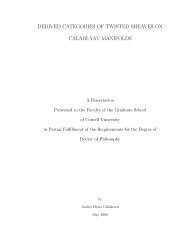Modifications of the Harmonic Series - Department of Mathematics
Modifications of the Harmonic Series - Department of Mathematics
Modifications of the Harmonic Series - Department of Mathematics
You also want an ePaper? Increase the reach of your titles
YUMPU automatically turns print PDFs into web optimized ePapers that Google loves.
ase representations. For example, <strong>the</strong> modified series where no denominator<br />
contains <strong>the</strong> digit 2 in its base 3 representation would look like this:<br />
2.2 “Exact” Values<br />
1 1 1 1 1 1 1 1<br />
S = + + + + + + + + ... .<br />
1 10 11 100 101 110 111 1000<br />
These modified harmonic series converge extremely slowly, so it is<br />
impossible to compute <strong>the</strong>ir sums directly. However, an indirect method for<br />
calculating <strong>the</strong> sums to extreme accuracy was found by Robert Baillie [11]. His<br />
method gives <strong>the</strong> sums <strong>of</strong> <strong>the</strong> modified series up to 20 decimal places.<br />
series<br />
Baillie’s method uses not only <strong>the</strong> modified harmonic series, but also <strong>the</strong><br />
j<br />
x S x− ∑ for j ≥ 1 where S is <strong>the</strong> set <strong>of</strong> positive integers that do not contain<br />
∈<br />
<strong>the</strong> forbidden digit. All <strong>of</strong> <strong>the</strong> series are partitioned into groups based on <strong>the</strong> number<br />
<strong>of</strong> digits in <strong>the</strong> denominator such that<br />
j<br />
si ( , j) x −<br />
= ∑ where x has exactly i digits.<br />
The sums <strong>of</strong> <strong>the</strong> first few groups, i ≤ 5,<br />
are calculated directly. Then a recursion<br />
formula is used to calculate <strong>the</strong> sum <strong>of</strong> <strong>the</strong> next group, si ( + 1, j)<br />
, by summing <strong>the</strong><br />
previous groups, si (, j+ n)<br />
with 0≤n≤ 10.<br />
(Increasing <strong>the</strong> upper bound on n would<br />
increase <strong>the</strong> accuracy <strong>of</strong> <strong>the</strong> final answer.) After values have been calculated for<br />
i ≤ 30<br />
, <strong>the</strong> tail <strong>of</strong> <strong>the</strong> modified harmonic series is estimated. Then <strong>the</strong> calculated sum<br />
<strong>of</strong> <strong>the</strong> modified harmonic series is <strong>the</strong> sum <strong>of</strong> <strong>the</strong> si (,1) , with 1 ≤i≤30, plus <strong>the</strong><br />
estimated tail.<br />
In his paper, Baillie published values for series with <strong>the</strong> digits 0 through 9<br />
forbidden– see Table 1.<br />
9<br />
x∈S
















